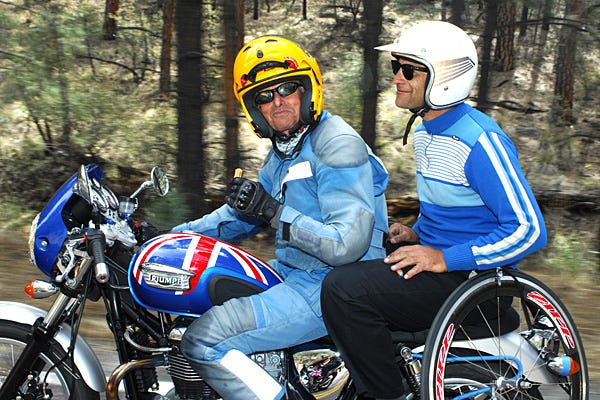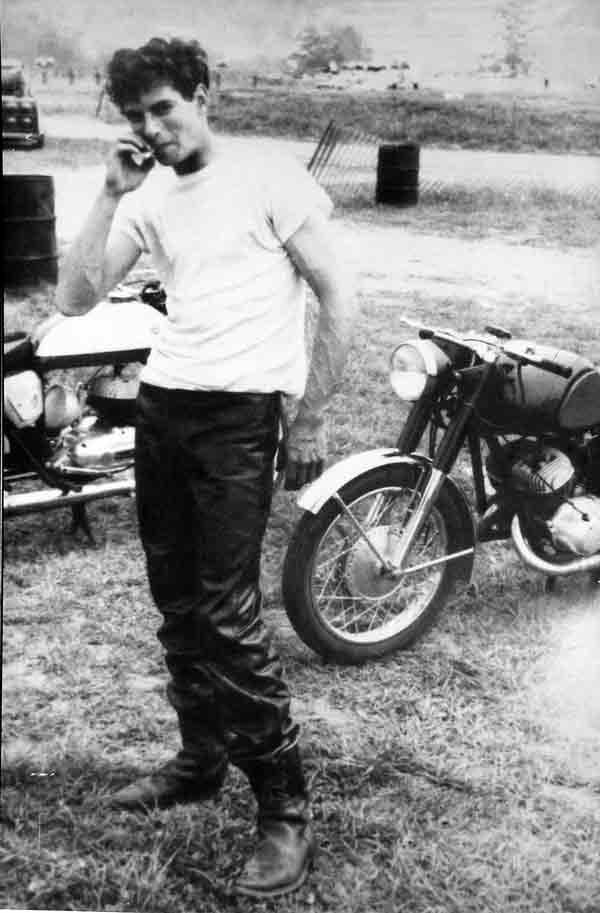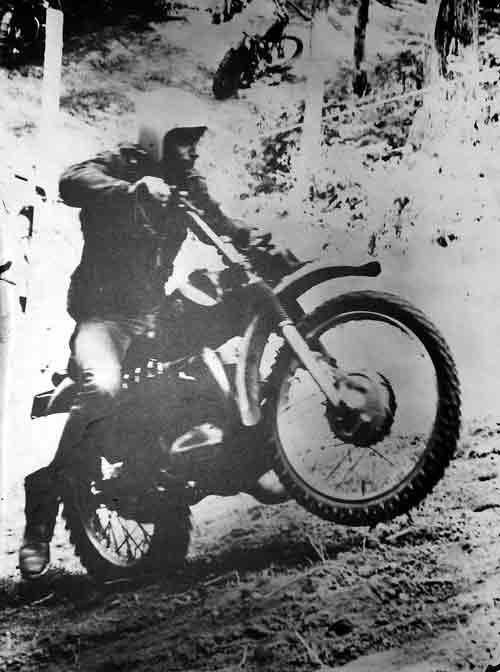
Happy holidays! With lovely weather beckoning me to ride bicycles and motorcycles here in northern California, I haven’t made the time to go deep and prepare Part 3 of our European motorcycle adventure.
In the meantime, many readers have commented on enjoying the bicycle/motorcycle tie-ins here, so I decided to reprint an interview I published with Maynard in August 2017. Part 2 with Maynard will go out this Thursday, with more Alps excitement resuming next week.
The name Maynard Hershon is familiar to avid bicyclists and motorcyclists. For years the Midwest native’s byline appeared in several cycling publications, including Winning and VeloNews. His books Tales From The Bike Shop and Half-Wheel Hell are both dog-eared best sellers. But Hershon has lived a double life for decades, also writing for a handful of motorcycle publications, namely CityBike.
By the time I was on the hunt for my first motorcycle in late 1999, I’d befriended Hershon by association. I worked at the old Schwinn Paramount factory for Rivendell Bicycle Works in Waterford, Wisconsin for two years in the mid `90s. Hershon and Rivendell’s owner Grant Petersen went back several years, so our paths crossed a few times. I heard he was into motorcycles, so with some extra cash in my pocket, I asked Hershon what to buy; I was leaning toward something vintage from Triumph, Norton or BSA.
“BMW,” he replied during an extensive email exchange. “One cannot go wrong with a BMW from the ‘70s. Find something like a R 90/6 or R 75/5, and you’ll be set.” The next day I found a 1975 R 90/6 for $2,400 from the original owner in Dayton, Ohio, where we were living at the time. Hershon’s advice was spot-on: I owned that beauty for eight years, riding it all around the hills of southwest Ohio, then through the Santa Cruz mountains by the time we relocated to California in mid 2006. I sold it to a newer rider in June 2008, right before the economy crashed. It wasn’t getting much use, and I felt it needed to go up for adoption to a better home.
Hershon’s name kept popping up in my sphere the past couple years. In March 2015 I befriended Surj Gish, the new owner of CityBike. I wrote a couple articles for him, and noticed Hershon’s column for the first time. All those years of reading his cycling words melted away, and the motorcycling Hershon took center stage. I emailed him like a newly baptized sinner, sharing my joy of now owning a pair of Moto Guzzis. As usual, he was gracious and excited for my conversion. It was the jolt I needed to make a wholesale switch from the bicycle industry to the motorized.
Here’s a fun interview I did with Hershon, now 75 and living in Denver, Colorado. He has too much real-world experience and adventure to pass up. And his advice to newer riders is priceless!
I’ve seen pictures of you riding or standing near motorcycles dating back to the 1960s. When did you first start riding, and who was your inspiration?
I started in 1962 when I got out of the service. A friend in the Air Force with me was a car nut from Portland, Oregon. We middle class guys were all car guys. None of us knew any motorcyclists. Alas, none of us could afford the cars of our dreams then, much like today.

He told me about these new motorcycles from Japan, Hondas they were, that had overhead cams and huge alloy brakes and 8,500 rpm redlines. The day after my discharge I bought a CB72, a 250 Honda Hawk, the little brother of the 305cc Super Hawk.
How quickly did the racing bug bite? How long did you race, and where did that adventure take you in the U.S.?
I worked in a couple of motorcycle shops in Bloomington, Indiana, after quitting Indiana University. I bought a Ducati Diana, one of the four-speed ones, and tried to ride a road race at Nelson Ledges in Ohio, where Gary Nixon on a Yamaha passed me going 50 mph faster than I could go—at my terrified limit. I met Gary at one of the Indy MotoGPs years later and refrained from thanking him for the epiphany. I was sure he’d heard it before.

I bought a Bultaco Matador, a 200, and rode some enduros and races in the woods, what we’d have called hare scrambles in the west. I had fun riding in the woods and kept doing it after my first wife and I moved to the Bay Area in ‘66. I even rode a few AFM road races on my 175 Ossa. I was pitifully slow.
You’ve been a cycling journalist since 1983 and a motorcycle journalist since 1985. When did you begin writing?
I was working in a bicycle shop in Marin County. The phone rang. It was an editor from a new cycling newspaper, looking for someone to cover local racing. I’d been back at school, getting an English degree, and taking journalism classes from a no-nonsense teacher. He made me feel that if I could pass his class, I had the tools. So I took that job.
They never liked me much at that paper, but I was now a published kinda guy. An opportunity fell in my lap to write a column in a national bicycle racing magazine called Winning. I submitted a piece; They didn’t like it. I submitted another, and they took it.
Suddenly I was the only guy writing in English about cycling who had a hole in a magazine that he could fill as he saw fit. I became the voice of a certain kind of bicycle rider. That gig lasted 11 years, and made me a known name all over the country.
A couple of years after I began with Winning, I saw that there was a new monthly motorcycle newspaper in the Bay Area called CityBike. I sent them a nostalgic piece and they ran it. I’ve been in CityBike for 32 years.
About 20 years ago, a British motorcycle magazine that I loved ceased publishing. Broke my heart. I wrote a eulogy. Somehow, Motorcycle Sport rose from the ashes and began again. An American who had read my sad piece sent it to the editor. They ran a segment of it in their born-again issue, thrilling me to the core.
I sent them an envelope full of CityBike pieces and they asked me to contribute, I’m delighted to say. Now the magazine is called Motorcycle Sport and Leisure. It’s hard to find in the US but worth it. I’m proud of it and my minor contribution. At this point I may be the longest-serving contributor.
Let’s talk about steel, one of our shared favorite materials. In my research on the Norton Commando, I discovered that Reynolds 531 tubing was used to make the Featherbed frames for the Manx racers. I was also working at Waterford when we built you that S&S coupled bike to take to the Reynolds factory in the late 1990s. The tubing was also used on the Jaguar E-Type subframes in the 1960s. What are your thoughts on the prevailing use of carbon fiber these days across the spectrum of bicycle and motorsports manufacturing?
I have three bicycles, all steel, not because I demand steel and wouldn’t ride anything else, but because I have always been happy with it and don’t feel that I would be faster or happier on carbon fiber. Money matters here too. I just read that second-tier bicycles are now $5,000. If I had $5,000 in discretionary income, I’d buy a motorcycle, not a bicycle.
I think of $5,000 as motor vehicle money, not bicycle money.
Stay tuned for Part Two of my interview with Maynard, where he talks about his years piloting motorcycles during major US bicycle races, the bikes he should’ve kept, and the advice he has for new riders.




Lately we've been watching some older bicycle races, seeing the motorcycles toting photographers, squeezing between the crowd and the cars and the riders - amazing!